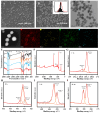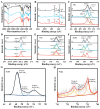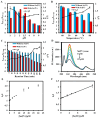A Ratiometric Fluorescence Method Based on PCN-224-DABA for the Detection of Se(IV) and Fe(III)
- PMID: 39727891
- PMCID: PMC11675067
- DOI: 10.3390/bios14120626
A Ratiometric Fluorescence Method Based on PCN-224-DABA for the Detection of Se(IV) and Fe(III)
Abstract
In this study, 3,4-diaminobenzoic acid (DABA) was introduced into the porphyrin metal-organic framework (PCN-224) for the first time to prepare a ratiometric fluorescent probe (PCN-224-DABA) to quantitatively detect ferric iron (Fe(III)) and selenium (IV) (Se(IV)). The fluorescence attributed to the DABA of PCN-224-DABA at 345 nm can be selectively quenched by Fe(III) and Se(IV), but the fluorescence emission peak attributed to tetrakis (4-carboxyphenyl) porphyrin (TCPP) at 475 nm will not be disturbed. Therefore, the ratio of I345nm/I475nm with an excitation wavelength of 270 nm can be designed to determine Fe(III) and Se(IV). After the experimental parameters were systematically optimized, the developed method shows good selectivity and interference resistance for Fe(III) and Se(IV) detection, and has good linearity in the ranges of 0.01-4 μM and 0.01-15 μM for Fe(III) and Se(IV) with a limit of detection of 0.045 μM and 0.804 μM, respectively. Furthermore, the quenching pattern was investigated through the Stern-Volmer equation, and the results suggest that both Se(IV) and Fe(III) quenched on PCN-224-DABA can be attributed to the dynamic quenching. Finally, the constructed ratiometric fluorescent probe was applied in the spiked detection of lake water samples, which shows good applicability in real sample analysis. Moreover, the Fe(III) and Se(IV) contents in spinach and selenium-enriched rice were determined, respectively.
Keywords: ferric iron; porphyrin metal–organic framework; quenching; ratiometric fluorescence; selenium.
Conflict of interest statement
Author Wen-Jia Li and Zheng-Ming Qian were employed by the company Dongguan HEC Cordyceps R&D Co., Ltd. The remaining authors declare that the research was conducted in the absence of any commercial or financial relationships that could be construed as a potential conflict of interest. .
Figures









Similar articles
-
Rapid and selective detection of Fe (III) by using a smartphone-based device as a portable detector and hydroxyl functionalized metal-organic frameworks as the fluorescence probe.Anal Chim Acta. 2019 Oct 24;1077:160-166. doi: 10.1016/j.aca.2019.05.062. Epub 2019 May 29. Anal Chim Acta. 2019. PMID: 31307705
-
Dandelion-like covalent organic frameworks with high-efficiency fluorescence for ratiometric sensing and visual tracking-by-detection of Fe3.Anal Chim Acta. 2023 Jan 25;1239:340671. doi: 10.1016/j.aca.2022.340671. Epub 2022 Nov 24. Anal Chim Acta. 2023. PMID: 36628754
-
Ratiometric Fluorescence Assay for Pyrophosphate Based on Sulfur Nanodots Decorated Metal-Organic Frameworks.Chemistry. 2023 Jun 22;29(35):e202300366. doi: 10.1002/chem.202300366. Epub 2023 May 3. Chemistry. 2023. PMID: 37051734
-
A ratiometric lanthanide-free fluorescent probe based on two-dimensional metal-organic frameworks and carbon dots for the determination of anthrax biomarker.Mikrochim Acta. 2021 Feb 15;188(3):84. doi: 10.1007/s00604-021-04701-8. Mikrochim Acta. 2021. PMID: 33587161
-
A water-stable lanthanide metal-organic framework for fluorimetric detection of ferric ions and tryptophan.Mikrochim Acta. 2017;184(9):3363-3371. doi: 10.1007/s00604-017-2306-0. Epub 2017 Jun 13. Mikrochim Acta. 2017. PMID: 28845057 Free PMC article.
References
-
- Gebreeyessus G.D., Zewge F. A review on environmental selenium issues. SN Appl. Sci. 2019;1:55. doi: 10.1007/s42452-018-0032-9. - DOI
-
- Carey A., Lombi E., Donner E., de Jonge M.D., Punshon T., Jackson B.P., Guerinot M.L., Price A.H., Meharg A.A. A review of recent developments in the speciation and location of arsenic and selenium in rice grain. Anal. Bioanal. Chem. 2012;402:3275–3286. doi: 10.1007/s00216-011-5579-x. - DOI - PMC - PubMed
-
- Khan M.S., Soyk A., Wolf I., Peter M., Meyer A.J., Rausch T., Wirtz M., Hell R. Discriminative long-distance transport of selenate and selenite triggers glutathione oxidation in specific subcellular compartments of root and shoot cells in Arabidopsis. Front. Plant Sci. 2022;13:894479. doi: 10.3389/fpls.2022.894479. - DOI - PMC - PubMed
MeSH terms
Substances
Grants and funding
LinkOut - more resources
Full Text Sources

